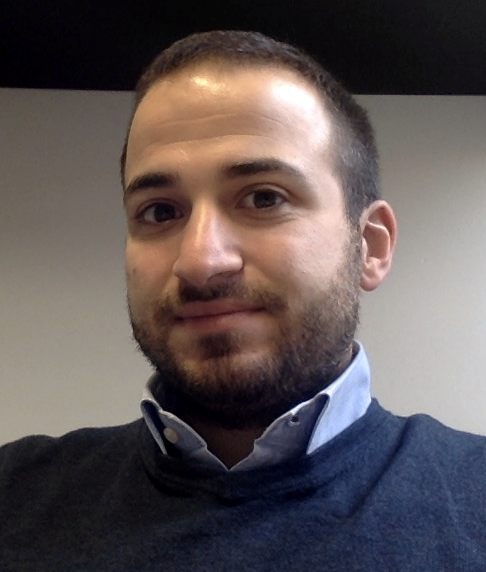 Biography: Dr Carmine Clemente is Lecturer and Chancellor’s Fellow in Sensors Systems and Asset Management at the Department of Electronic and Electrical Engineering at the University of Strathclyde, Glasgow, UK since 2016. He obtained his PhD in Signal Processing from the University of Strathclyde in 2012. He received the Laurea cum laude (BSc) and Laurea Specialistica cum laude (MSc) degrees in Telecommunications Engineering from Universita' degli Studi del Sannio, Benevento, Italy, in 2006 and 2009, respectively.
Biography: Dr Carmine Clemente is Lecturer and Chancellor’s Fellow in Sensors Systems and Asset Management at the Department of Electronic and Electrical Engineering at the University of Strathclyde, Glasgow, UK since 2016. He obtained his PhD in Signal Processing from the University of Strathclyde in 2012. He received the Laurea cum laude (BSc) and Laurea Specialistica cum laude (MSc) degrees in Telecommunications Engineering from Universita' degli Studi del Sannio, Benevento, Italy, in 2006 and 2009, respectively.
Dr Clemente research interests lie on advanced radar signal processing algorithms, MIMO radars, passive radar systems and micro-Doppler analysis, extraction and classification.
He published over 60 papers in journals and proceedings and he was co-recipient of the best student paper competition at the IEEE Radar conference 2015.
Title: Micro-Doppler Signatures: Principles, Analysis and applications
Abstract:
objective:The micro-Doppler analysis is the study of the time varying Doppler effect from multiple scattering centres with different dynamics. Over the past few years the potentials of micro-Doppler signature analysis has been demonstrated in areas such as enhanced target detection, characterization and tracking. The advantage of micro-Doppler resides in the distinctive Doppler modulation from different targets components that allow unique features to be obtained.
This topic is highly relevant to the conference as micro-Doppler can play a significative role in modern radar systems in both civilian and defence applications. For instance, thanks to the enhance in computational capabilities, the exploitation of micro-Doppler analysis is possible in a plethora of applications such as condition monitoring, urban surveillance, automotive and manufacturing.
This topic is of great interest to both the academic and industrial community and it is expected that a good number of attendees (10-15) will be at the tutorial. The target attendees include all levels of professionals, from graduate students to professors and from engineers to industrial managers.
Outline:Introduction: the introduction to the basic Doppler principle will be given together with some basic concepts relevant to micro-Doppler acquisition and processing. The micro-Doppler phenomenon will be defined, then the importance of proper sampling and I/Q demodulation will be highlighted. Slow-time and fast-time differences together with the trade-offs required to observe micro-Doppler will be depicted;
Time-Frequency Analysis: introductions to the time-frequency analysis and the most used tools will be given. Wide-band and Narrowband Spectrogram, Gabor Uncertainty principle and Energy distributions will be explained with illustrative examples to provide a useful set of tools for micro-Doppler analysis;
Canonical Cases- Rigid Bodies: The basic principles of kinematic motion of rigid bodies will be given in order to investigate some canonical cases, rotation matrices will be also introduced in order to have all the audience at the same level of knowledge. The case of a vibrating point target and rotating body will be analysed, completing the first part of the tutorial with the case study of the micro-Doppler from a helicopter rotor;
Non Rigid Bodies: the micro-Doppler analysis from non-rigid bodies will be introduced. Modelling and simulation approaches will be described. Two cases will be investigated in detail: human gait and trotting of a German shepherd. For both cases the kinematic models translation in MATLAB environment will be analysed. Furthermore, the micro-Doppler signatures from different human activities will be introduced, including some resulting relevant in healthcare applications;
Signature Extraction Techniques: The importance of the extraction of the micro-Doppler from clutter and from the main body return will be introduced using some example signal processing techniques, such as background subtraction, filtering and subspace decompositions;
Algorithms for Feature Extraction for Micro-Doppler Based ATR: The specific case of target recognition based on micro-Doppler will be illustrated as example of micro-Doppler application. The principles of feature extraction and example of features extraction techniques applied to micro-Doppler will be given;
Real time recording and visualization of real radar data: Using a 24 GHz CW radar some real time data acquisition will be performed. The real time micro-Doppler will be shown in MATLAB allowing interactions from the tutorial attendees. A set of tips for experimental campaigns will be also provided